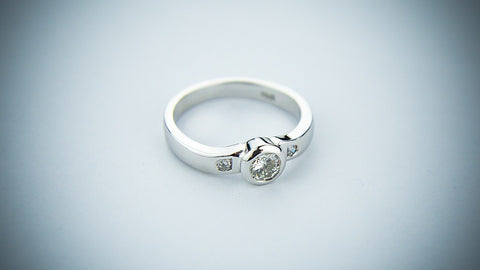If you have a piece of very shiny jewelry that dates back to the 1930s, then chances are high that you have a piece of rhodium-plated jewelry. There are a number of reasons why rhodium plating is popular for jewelry, but there are also certain caveats that you should know before purchasing rhodium-plated items.

(Pixabay / NicholasDeloitteMedia)
Rhodium and its Properties
Rhodium is a silvery-white, hard, and corrosion-resistant metal. It is very shiny and reflects up to 80 percent of light. Rhodium gives off one of the best sheens achievable, making it a very popular metal for jewelry. Rhodium is very rare as it is never found as a single mineral. Rather, it is cultivated in very small quantities within nickel and platinum ores. The production rate of the metal globally is roughly 30 tons yearly, which is actually very small compared to other metals. Copper, for example, is produced at a rate of 20 million metric tons per year. Aluminum comes in at 63 million metric tons. Combine this scarcity with the huge demand for rhodium and its high-shine appearance, and you can see why rhodium is the world's most expensive precious metal. In fact, it beats out both gold and silver by a huge margin.
Rhodium has been used as a coating for jewelry and silverware since the 1930s. It was also used as a plating for cigarette lighters and writing instruments during that time. One of the many companies that used rhodium plating was the Ronson Lighter Company, which produced many art-deco style items in the 30s.
Rhodium Pros and Cons
Like all metals, rhodium presents both advantages and disadvantages. One of the biggest pros of plating jewelry and other items with rhodium is the incredible luster that the metal imparts. Rhodium can create stunning pieces of jewelry. Of course, you will have to balance this remarkable sheen with the high price of the rhodium. Remember, though, that while the jewelry may seem very costly in the moment, you’ll be making a valuable investment that could serve you well later.
Another thing that you should note about rhodium plating is that since it is a coating on the surface of an object, it can wear off over time. The rate at which it wears off is determined by a myriad of factors such as the thickness of the plating, amount of wear and tear the surface is exposed to, etc. This means that you should avoid washing or rubbing the exposed surface to lengthen the life of the jewelry. Remove your rhodium jewelry when going for a swim, as the chlorine in the water can heavily damage the plating. Your care will have a significant bearing on the integrity of your jewelry.
If you are considering rhodium-plated jewelry, weigh the pros and cons, and take your budget into account. If you have the funds for rhodium and take good care of your items, they can last you years into the future, make a stunning statement, and prove to be a valuable investment.
